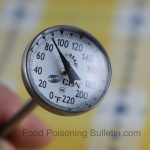As food safety lawyers, people have been asking us (from a distance) how worried they should be about COVID-19 and the safety of their takeout food? While we can’t tell them about viral transmission rates via various sources – we’re lawyers, not scientists - we can tell them what we have learned from years of representing people sickened by germs in restaurant food. Good sanitary conditions and safe food preparation processes and procedures (food safety plans) are very important…but it all fails when employee training fails. Obviously, when food safety plans are bad (for example, if they do not include proper testing of food storage areas for correct temperature control or mandate specific locations to keep raw foods from cross-contaminating cooked foods) then germs can spread. Too … [Read more...]
How Do You Know If You Have a Cyclospora Infection?
Every year for the last several years in the United States, there has been a massive cyclospora outbreak that sickens thousands. In fact, last year several cyclospora outbreaks sickened more than 2,400 people. One of those outbreaks that was linked to imported fresh basil sickened more than 240 people across the country and was the number four outbreak for 2019. So how do you know if you have a cyclospora infection? Cyclosporiasis is the illness caused by this single celled parasite called Cyclospora cayetanensis. People get sick by eating food or drinking water contaminated with the parasite. This infection is not spread person-to-person, since the oocyte needs time, usually one to two weeks, to sporulate and become infectious after it is expelled in feces. The parasite is … [Read more...]
Cryptosporidium Outbreaks Have Increased by 13% Year Over Year
According to a study published in the CDC's Morbidity and Mortality Weekly Report, cryptosporidium outbreaks in 40 states and Puerto Rico have increased by 13% year over year in this country. Leading causes for this illness include swallowing contaminated water in pools or water playgrounds, contact with infected cattle, and contact with infected people in childcare settings. From 2009 to 2017, there were 444 cryptosporidiosis outbreaks from 40 states and Puerto Rico that caused 7,465 illnesses. Twenty-two of those outbreaks were associated with unpasteurized milk and apple cider. And the report states that the outbreaks likely underestimate the actual number of cryptosporidiosis outbreaks, and the reported number of cases "likely underestimate the actual magnitude of individual … [Read more...]
Foodborne Illnesses Increased in 2018 Compared to 2015-2017
Foodborne illnesses increased in 2018 compared to the period of 2015-2017, according to a new report by the Center for Disease Control for its Weekly Morbidity and Mortality Report for the week of April 26, 2019. The report states that this increase may are partially attributable to increased culture-independent diagnostic tests (CIDTs). CIDT identifies pathogens that were not routinely detected by other methods. During 2018, FoodNet identified 25,606 infections, 5,893 hospitalizations, and 120 deaths. The incidence of cyclospora infections increased "markedly," in 2018 because there were several large outbreaks associated with produce. And the number of illnesses caused by Campylobacter and Salmonella remain high. FoodNet surveils the population for lab-diagnosed infections … [Read more...]
Lawyer Asks: Why Are There Ground Beef E. coli Outbreaks?
One April, 2019 morning, amidst the ongoing ground beef E. coli O103 outbreak affecting much of the east-central United States, one of the attorneys on the foodborne illness team at the Pritzker Hageman law firm began her weekly meal preparation ritual. She went to her freezer and grabbed two pounds of frozen ground beef, defrosted it, and put it in a frying pan to brown. She has said her family of four goes through so much ground beef that she regularly fill my freezer with a “quarter of beef” raised by her father and processed by a local butcher shop. Her family "lives on it". In the U.S., a family’s subsistence on ground beef is not uncommon. For 2018, Americans were projected to eat 222.2 pounds of meat and poultry, each. According to the self-proclaimed “best information … [Read more...]
CDC Surveillance Report Reveals Outbreak Numbers, But Not Consequences of Foodborne Illness
The CDC Surveillance Report for Foodborne Disease Outbreaks from 2009 - 2015 was released in the Morbidity and Mortality Weekly Report today. The numbers show that food poisoning outbreaks remain a serious health problem in this country, causing millions of illnesses every year. But what the raw numbers don't reveal is how these largely preventable illnesses wreak havoc on individual lives and families. During the time frame of the report, the CDC's Foodborne Disease Outbreak Surveillance System received reports of 5,760 outbreaks that caused more than 100,000 illnesses, more than 5500 hospitalizations, and 145 deaths. These outbreak illnesses are a small fraction of the actual number of food poisoning cases that occur every year. The government estimates that 48,000,000 … [Read more...]
It’s State and County Fairs Time; Stay Safe at Animal Exhibits
As summer winds down and fall approaches, state and county fairs are underway. The CDC is warning parents and caregivers about ways to protect yourself and your children against E. coli and other illnesses that have been linked to those events. Animals exhibits and petting zoos at county and state fairs have been the source of E. coli outbreaks in the past few years. From 2010 to 2015, about 100 outbreaks of illness were linked to animals in public settings. These outbreaks have been caused by E. coli O157:H7, Cryptosporidium, and Salmonella bacteria. Last year, eight people were sickened with E. coli infections after visiting the Mesa County Fair in Colorado Junction, Colorado. An E. coli outbreak in Minnesota in 2014 was linked to Zerebko Zoo Tran, a traveling petting zoo. At … [Read more...]
Prevent Clostridium Perfringens Illnesses This Holiday Season
Clostridium perfringens food poisoning cases tend to spike around the holiday season. This bacteria causes almost 1,000,000 cases of food poisoning every year. The bacteria grows when large pots and containers of food are not kept from the danger zone of 40°F to 140°F. Restaurants, nursing homes, potlucks, and large parties are usually the sources of this type of outbreak. So FoodSafety.gov is offering tips to help stop this type of food poisoning. The bacteria is found on raw meat and poultry, in the environment, and in the intestines of people and animals. Some strains produce a toxin as the bacteria grows. This type of food poisoning has a sudden and fast onset, usually within a few hours of exposure to the pathogenic bacteria. Diarrhea is the main symptoms. This type of … [Read more...]
Learn How to Select and Serve Produce Safely
Summer is a time when everyone enjoys eating more fresh produce. But there have been many foodborne illness outbreaks in the past few years linked to fresh fruits and vegetables. Some of the pathogens in those outbreaks include Salmonella, E. coli, Listeria monocytogenes, and cyclospora. The FDA is offering tips to help you choose and serve fresh produce safely. Harmful bacteria can be in the irrigation water used in the fields. Animals can poop on the plants, transferring pathogenic bacteria onto the fruits and vegetables. Product can also be contaminated during harvest, processing, or transport. When you buy produce, always choose products that are not damaged, cut, or bruised. Those injuries are open doorways to pathogens. Once the pathogens are inside the fruit or vegetable, … [Read more...]
FDA Releases Year 5 Reportable Food Registry
The Reportable Food Registry is released by the Food and Drug Administration every year. It is a synopsis of a one-year reporting period from the Registry. The current edition is the 5th Annual Report: September 8, 2009 through September 7, 2014. The FDA is required to establish an electronic portal. Reports about instances of reportable food must be submitted to the FDA within 24 hours. A reportable food is an article of food or feed for which there is reasonable probability that the use of, or exposure to, such article of food will cause serious adverse health consequences or death to people or animals. The RFR is considered an early warning tool for public health risks and helps the government remove contaminated foods from the marketplace. The RFR covers all human and animal … [Read more...]














